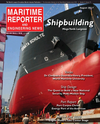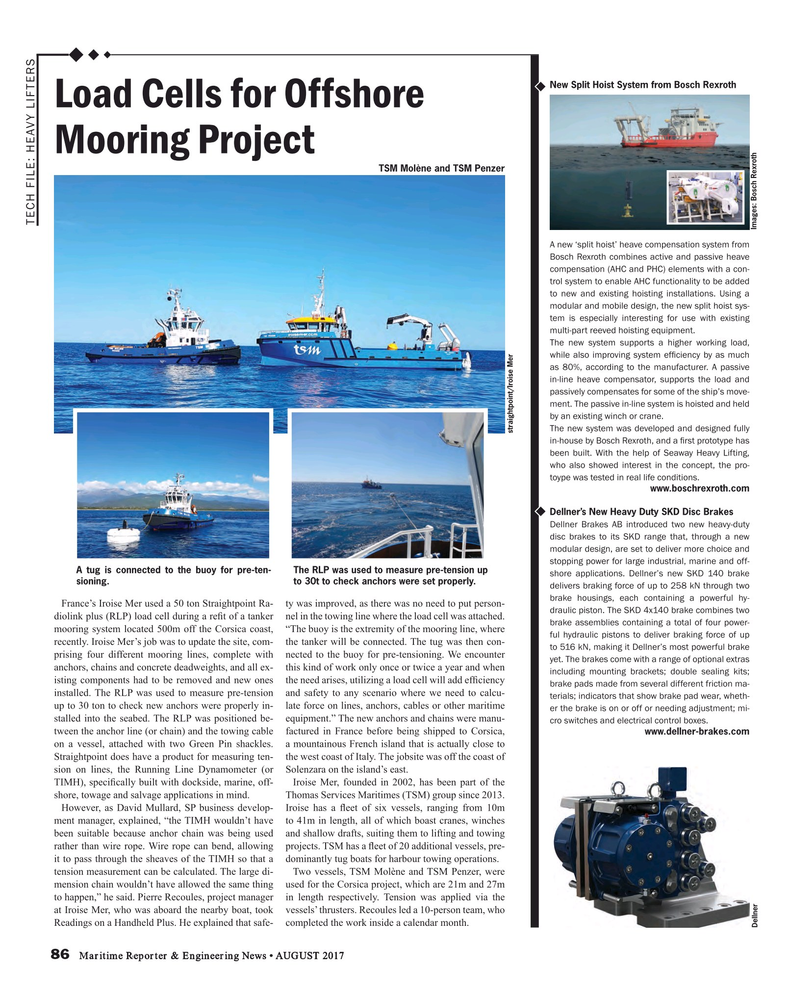
Page 86: of Maritime Reporter Magazine (August 2017)
The Shipyard Edition
Read this page in Pdf, Flash or Html5 edition of August 2017 Maritime Reporter Magazine
New Split Hoist System from Bosch Rexroth
Load Cells for Offshore
Mooring Project
TSM Molène and TSM Penzer
TECH FILE: HEAVY LIFTERS
Images: Bosch Rexroth
A new ‘split hoist’ heave compensation system from
Bosch Rexroth combines active and passive heave compensation (AHC and PHC) elements with a con- trol system to enable AHC functionality to be added to new and existing hoisting installations. Using a modular and mobile design, the new split hoist sys- tem is especially interesting for use with existing multi-part reeved hoisting equipment.
The new system supports a higher working load, while also improving system ef? ciency by as much as 80%, according to the manufacturer. A passive in-line heave compensator, supports the load and passively compensates for some of the ship’s move- ment. The passive in-line system is hoisted and held by an existing winch or crane.
The new system was developed and designed fully straightpoint/Iroise Mer in-house by Bosch Rexroth, and a ? rst prototype has been built. With the help of Seaway Heavy Lifting, who also showed interest in the concept, the pro- toype was tested in real life conditions.
www.boschrexroth.com
Dellner’s New Heavy Duty SKD Disc Brakes
Dellner Brakes AB introduced two new heavy-duty disc brakes to its SKD range that, through a new modular design, are set to deliver more choice and stopping power for large industrial, marine and off-
A tug is connected to the buoy for pre-ten- The RLP was used to measure pre-tension up shore applications. Dellner’s new SKD 140 brake sioning. to 30t to check anchors were set properly.
delivers braking force of up to 258 kN through two brake housings, each containing a powerful hy-
France’s Iroise Mer used a 50 ton Straightpoint Ra- ty was improved, as there was no need to put person- draulic piston. The SKD 4x140 brake combines two diolink plus (RLP) load cell during a re? t of a tanker nel in the towing line where the load cell was attached. brake assemblies containing a total of four power- mooring system located 500m off the Corsica coast, “The buoy is the extremity of the mooring line, where ful hydraulic pistons to deliver braking force of up recently. Iroise Mer’s job was to update the site, com- the tanker will be connected. The tug was then con- to 516 kN, making it Dellner’s most powerful brake prising four different mooring lines, complete with nected to the buoy for pre-tensioning. We encounter yet. The brakes come with a range of optional extras anchors, chains and concrete deadweights, and all ex- this kind of work only once or twice a year and when including mounting brackets; double sealing kits; isting components had to be removed and new ones the need arises, utilizing a load cell will add ef? ciency brake pads made from several different friction ma- installed. The RLP was used to measure pre-tension and safety to any scenario where we need to calcu- terials; indicators that show brake pad wear, wheth- up to 30 ton to check new anchors were properly in- late force on lines, anchors, cables or other maritime er the brake is on or off or needing adjustment; mi- stalled into the seabed. The RLP was positioned be- equipment.” The new anchors and chains were manu- cro switches and electrical control boxes.
tween the anchor line (or chain) and the towing cable factured in France before being shipped to Corsica, www.dellner-brakes.com on a vessel, attached with two Green Pin shackles. a mountainous French island that is actually close to
Straightpoint does have a product for measuring ten- the west coast of Italy. The jobsite was off the coast of sion on lines, the Running Line Dynamometer (or Solenzara on the island’s east.
TIMH), speci? cally built with dockside, marine, off- Iroise Mer, founded in 2002, has been part of the shore, towage and salvage applications in mind. Thomas Services Maritimes (TSM) group since 2013.
However, as David Mullard, SP business develop- Iroise has a ? eet of six vessels, ranging from 10m ment manager, explained, “the TIMH wouldn’t have to 41m in length, all of which boast cranes, winches been suitable because anchor chain was being used and shallow drafts, suiting them to lifting and towing rather than wire rope. Wire rope can bend, allowing projects. TSM has a ? eet of 20 additional vessels, pre- it to pass through the sheaves of the TIMH so that a dominantly tug boats for harbour towing operations.
tension measurement can be calculated. The large di- Two vessels, TSM Molène and TSM Penzer, were mension chain wouldn’t have allowed the same thing used for the Corsica project, which are 21m and 27m to happen,” he said. Pierre Recoules, project manager in length respectively. Tension was applied via the at Iroise Mer, who was aboard the nearby boat, took vessels’ thrusters. Recoules led a 10-person team, who
Readings on a Handheld Plus. He explained that safe- completed the work inside a calendar month.
Dellner 86 Maritime Reporter & Engineering News • AUGUST 2017
MR #8 (82-89).indd 86 MR #8 (82-89).indd 86 8/7/2017 4:49:39 PM8/7/2017 4:49:39 PM

 85
85

 87
87
